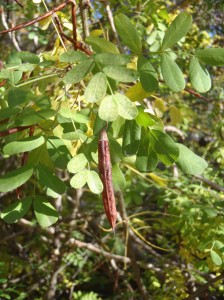 Caragana has a reputation similar to that of poplar trees, verging on “weed” status. The growth has a spiny appearance that most find unattractive. The plants sucker, and produce exploding pods that throw seeds everywhere. Plus they require lots of trimming just to stay presentable.
Caragana has a reputation similar to that of poplar trees, verging on “weed” status. The growth has a spiny appearance that most find unattractive. The plants sucker, and produce exploding pods that throw seeds everywhere. Plus they require lots of trimming just to stay presentable.
Caragana is native to places like (go figure…) Siberia, and was brought to the Canadian west in the 1880s.[1] It is extremely drought-resistant and was used extensively in farmhouse shelterbelts. I would guess that it’s the second most common hedge in Edmonton, after cotoneaster, though you are much more likely to see it in older communities like Garneau than, say, Terwilliger. It also grows wild in the Edmonton river valley.
In the early summer, caragana shrubs grow slender, green, bean-like pods. In late summer the pods turn brown, thin-skinned, and brittle. The seeds within develop a fantastic flavour that reminds me of green pea and asparagus, with a profound, sweet, nuttiness. For a short while I eat them raw from the shell. As they dry further, they have to be boiled like other legumes.
After the pods have thoroughly dried, they burst and release the seeds. This bursting is actually quite dramatic. The first time I picked caragana I collected the pods in a large glass jar. Every so often there was a popping sound, and some of the pods would jump out of the container. I kept picking through the jar because I thought a grasshopper had fallen into it. After popping, the two halves of the pod twist around themselves to resemble spiral shank nails. (If you click on the above photo, you can see some twisted pod shells in the top left corner.) Obviously, the pods need to be collected before they burst.
So here’s the catch: the pods contain maybe six seeds that are each about a half centimeter across. Foraging is tedious, to the point that I don’t know if you would realistically collect enough seeds to serve as a legume dish for dinner. They might be better scattered through salads. Depends how persistent you are, I guess.
As I write this, the caragana are throwing the last of their seeds onto the autumn ground. If you hurry, you can have one last taste to contemplate over the winter.
Reference
1. Skinner, Hugh, and Williams, Sara. Best Trees and Shrubs for the Prairies. ©2004 Hugh Skinner and Sara Williams. Page 73.
This has been my go-to book for information on local trees and shrubs for a few years now. It has an ornamental bent, and is very conservative on edibility issues. It makes no comment on caragana’s edibility.